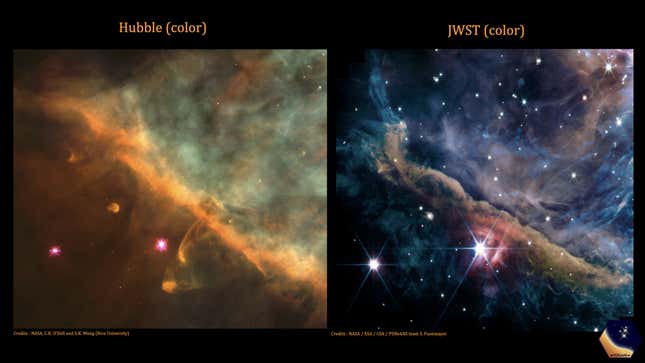
The Webb Telescope recently imaged a region of the Orion Nebula associated with star birth, and the result is about what we’ve come to expect from the cutting-edge space observatory.
I’m not saying that the image is bad. It’s quite nice! It was taken with the telescope’s NIRCam instrument and captures an inner region of the Orion Nebula.
But, I must say, it’s not quite as thrilling as Webb’s recent conquests: a deep field eight times larger than the telescope’s first, the eerie tendrils of the Tarantula Nebula, and the observatory’s first direct image of an exoplanet.
This image was taken as part of Webb’s early science program by the PDRs4All scientific collaboration. The collaboration’s goal is to image Photo-Dissociation Regions (PDRs), where ultraviolet light from stars creates warm regions of gas and dust in space.
The predominant feature here is the Orion Bar, a massive belt of gas and dust, which appears brownish-yellow. Toward the center of the bar is a bright star, θ2 Orionis A. The star is bright enough to be visible from Earth with the naked eye, if the observer is in a dark enough place.

The image is peppered with hot, young stars, especially toward the upper right corner. These stars are collectively known as the Trapezium Cluster; their ultraviolet radiation is slowly eroding the Orion Bar. So an image that at first glance looks to capture a giant space mustache shows a more dynamic phenomenon than you might expect.
Set next to an earlier image of the Orion Nebula taken by the Hubble Space Telescope, Webb’s impressive quality is more apparent. The Webb image shows cooler material than Hubble’s, where hot gas is the main attraction. Webb’s infrared instruments are an improvement on Hubble’s in that they can peer through clouds of dust and gas, to see star-forming regions and other areas of astrophysical intrigue.
When Webb’s images debuted, they appeared almost shockingly resolved. Now, that novelty has faded a bit, as we’ve grown accustomed to seeing the cosmos in what was once unprecedented detail. But setting Webb images next to Hubble shots—no disrespect to Hubble—is a great reminder of how much our observational technology has improved. It’s also a reminder of how our knowledge of the cosmos is only as good as our best technology.